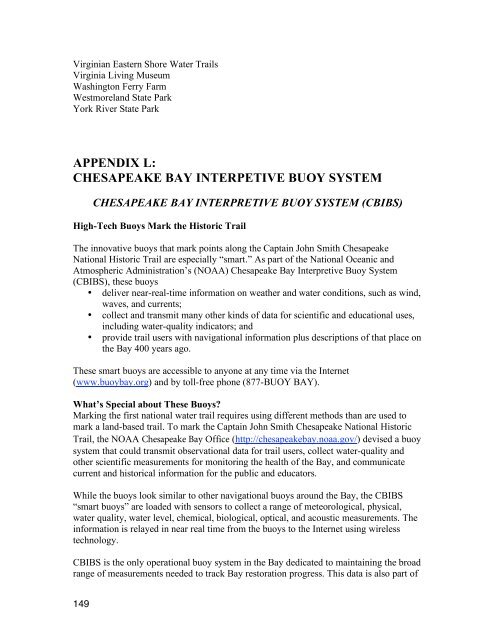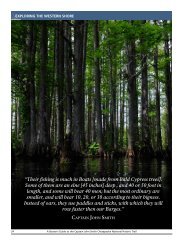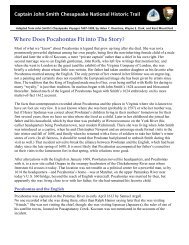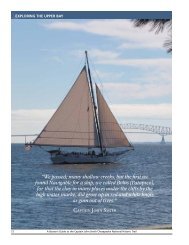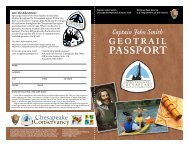Draft Interpretive Plan Join the adventure! - Captain John Smith ...
Draft Interpretive Plan Join the adventure! - Captain John Smith ...
Draft Interpretive Plan Join the adventure! - Captain John Smith ...
Create successful ePaper yourself
Turn your PDF publications into a flip-book with our unique Google optimized e-Paper software.
Virginian Eastern Shore Water Trails<br />
Virginia Living Museum<br />
Washington Ferry Farm<br />
Westmoreland State Park<br />
York River State Park<br />
APPENDIX L:<br />
CHESAPEAKE BAY INTERPETIVE BUOY SYSTEM<br />
CHESAPEAKE BAY INTERPRETIVE BUOY SYSTEM (CBIBS)<br />
High-Tech Buoys Mark <strong>the</strong> Historic Trail<br />
The innovative buoys that mark points along <strong>the</strong> <strong>Captain</strong> <strong>John</strong> <strong>Smith</strong> Chesapeake<br />
National Historic Trail are especially “smart.” As part of <strong>the</strong> National Oceanic and<br />
Atmospheric Administration’s (NOAA) Chesapeake Bay <strong>Interpretive</strong> Buoy System<br />
(CBIBS), <strong>the</strong>se buoys<br />
• deliver near-real-time information on wea<strong>the</strong>r and water conditions, such as wind,<br />
waves, and currents;<br />
• collect and transmit many o<strong>the</strong>r kinds of data for scientific and educational uses,<br />
including water-quality indicators; and<br />
• provide trail users with navigational information plus descriptions of that place on<br />
<strong>the</strong> Bay 400 years ago.<br />
These smart buoys are accessible to anyone at any time via <strong>the</strong> Internet<br />
(www.buoybay.org) and by toll-free phone (877-BUOY BAY).<br />
What’s Special about These Buoys?<br />
Marking <strong>the</strong> first national water trail requires using different methods than are used to<br />
mark a land-based trail. To mark <strong>the</strong> <strong>Captain</strong> <strong>John</strong> <strong>Smith</strong> Chesapeake National Historic<br />
Trail, <strong>the</strong> NOAA Chesapeake Bay Office (http://chesapeakebay.noaa.gov/) devised a buoy<br />
system that could transmit observational data for trail users, collect water-quality and<br />
o<strong>the</strong>r scientific measurements for monitoring <strong>the</strong> health of <strong>the</strong> Bay, and communicate<br />
current and historical information for <strong>the</strong> public and educators.<br />
While <strong>the</strong> buoys look similar to o<strong>the</strong>r navigational buoys around <strong>the</strong> Bay, <strong>the</strong> CBIBS<br />
“smart buoys” are loaded with sensors to collect a range of meteorological, physical,<br />
water quality, water level, chemical, biological, optical, and acoustic measurements. The<br />
information is relayed in near real time from <strong>the</strong> buoys to <strong>the</strong> Internet using wireless<br />
technology.<br />
CBIBS is <strong>the</strong> only operational buoy system in <strong>the</strong> Bay dedicated to maintaining <strong>the</strong> broad<br />
range of measurements needed to track Bay restoration progress. This data is also part of<br />
149


